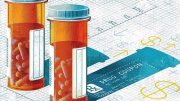For patients who depend on costly medications to stay healthy, co-pay coupons and patient assistance programs are popular ways to save money at the pharmacy counter. But research by Rauner professor of business administration Leemore Dafny, the Jay Fellow, finds with colleagues that these common “cost-saving” tools actually drive up the cost of prescription drugs.
Dafny, an economist who holds a joint appointment at the Harvard Kennedy School, began studying this topic more than a decade ago, prompted by the growing number of pharmaceutical ads that included coupons. Such coupons offer consumers a discount on the co-pay for the advertised drug and have grown increasingly popular; the share of brand-name prescription drug spending that included a coupon rose from 26 percent in 2007 to 90 percent in 2017, Dafny reports. And the number of drugs with available coupons rose from about 200 in 2008 to more than 800 in 2018.
Not everyone is eligible for coupons; Medicare enrollees are prohibited by law from using them. “The coupons are considered kickbacks or financial inducements to consume a product that is reimbursed by the federal government,” Dafny explains, and are therefore banned in that context. But pharmaceutical companies are permitted to donate to independent charities that subsidize co-pay assistance for patients, even those on Medicare, and to earmark those donations for conditions treated by drugs they make.
Dafny conducted her first analysis of co-pay coupons when she learned that Massachusetts bans a particular type of coupon: those that cover a brand-name pharmaceutical when there is a bioequivalent generic for that drug. “In a mature market, a generic is less than 20 percent the cost of the reference brand,” she explains. “If the manufacturer offers to cover your co-pay for the branded version, say $35, you might be happy to purchase it in place of the generic, which might have a $10 co-pay. But your insurance plan is paying the rest of the much higher brand-name cost. Massachusetts was alone among all states in banning such coupons.” Dafny and her coauthors compared insurance claims data from Massachusetts with that of neighboring New Hampshire, which does permit such coupons.
When they looked at branded drugs with coupons and a recently introduced generic version, they found that privately insured Massachusetts residents were more likely than those in New Hampshire to switch to the generic form of the drug when it became available. This difference in generic uptake was not present for users of Medicare, who can’t redeem coupons in any state. After this research was published, the state of California also banned coupons for branded drugs with bioequivalent generics.
In a forthcoming study, Dafny and coauthors Kate Ho of Princeton and Edward Kong of Harvard Medical School considered different coupons: those for branded drugs without bioequivalent generics. They obtained data from a large pharmacy benefits manager (PBM), a company that administers prescription drug plans for commercial insurers. Such companies keep their negotiated drug prices under wraps, but this PBM masked the information in a way that still allowed researchers to see details such as the relative prices of drugs and their price growth over time. They examined how volume and price among the privately insured enrollees changed for a drug after a coupon became available for that drug. As a control group, they used enrollees in Medicare Advantage, who cannot use co-pay coupons. The researchers’ analysis revealed that in the 12 months after a drug coupon was introduced, commercially insured patients increased their purchases of that drug by an average of 20 percent compared to people on Medicare Advantage. In the second part of the forthcoming study, Dafny and her coauthors conducted a detailed analysis of a category of drugs to treat multiple sclerosis (MS), using eight years of claims data from the independent nonprofit Health Care Cost Institute, which provides data to health care researchers. Their model estimated that “if you banned coupons, MS drug prices would be 8 percent lower, which in the U.S. means about a billion dollars less in spending,” Dafny reports—on MS prescriptions alone.
She and her colleagues hypothesize that coupons boost demand for brand-name drugs in part by influencing doctors’ prescribing habits. “Physicians want their patients to be able to access the drugs they prescribe,” Dafny says. “If they’re aware that there is assistance available either through a coupon or a co-pay assistance program, they’re likelier to consider prescribing the drug and become familiar with it.” One of the main ways that co-pay assistance and coupons lead to higher medication prices and insurance premiums, she explains, is that they limit a PBMs’ ability to negotiate lower prices on individual drugs. Historically, lower-priced medications were given “preferred” status and less expensive co-pays that encouraged patients to use them. But as coupons have grown popular, pharmaceutical companies have lost the incentive to negotiate favorable prices in order to be named a preferred drug, Dafny explains. In fact, patients can often pay a lower (or zero) out-of-pocket cost for an expensive drug even when a cheaper substitute is available because the expensive drug has a coupon.
In an additional study published this past fall, Dafny and her coauthors identified problems with the pharmaceutical companies’ charitable co-pay assistance programs for patients on Medicare. “Manufacturers are not supposed to earmark these funds for their own medications,” she says. But just a few companies make most of the medications involved, so the monies often go toward the purchase of those drugs. “I was surprised that there were quite a number of conditions where a huge share of the drug spending was going to just one manufacturer,” she adds, which she sees as a violation of the spirit of Medicare’s Anti-Kickback Statute. For example, for patients with short bowel syndrome, the drug of choice is Gattex, which is manufactured at a cost of nearly $300,000 per patient per year. The researchers calculated that 99.6 percent of all drug spending in 2017 for this condition was attributable to Gattex, approved by the FDA in December 2012, with a charitable fund for short bowel syndrome made public 10 days later.
Dafny calls for stricter regulation by the Department of Health and Human Service’s Office of the Inspector General, as well as expanded coupon bans. “We need to do much more to reduce out-of-pocket drug costs for patients requiring medications,” she adds, “but relying on pharmaceutical companies to decide which drugs are subsidized is not the way to do that.”
“I get hate mail occasionally when I am quoted as being in favor of co-pay coupon bans,” Dafny says, but she stresses that bans must also be paired with caps on cost-sharing for patients. “My objective is not to make sick people pay more for their drugs, nor am I saying that all cost-sharing that exists in insurance companies is optimal,” she says. “I’m just saying that co-pay coupons are contributing to higher drug prices, and that’s not helpful in light of our steep health care spending right now.”









